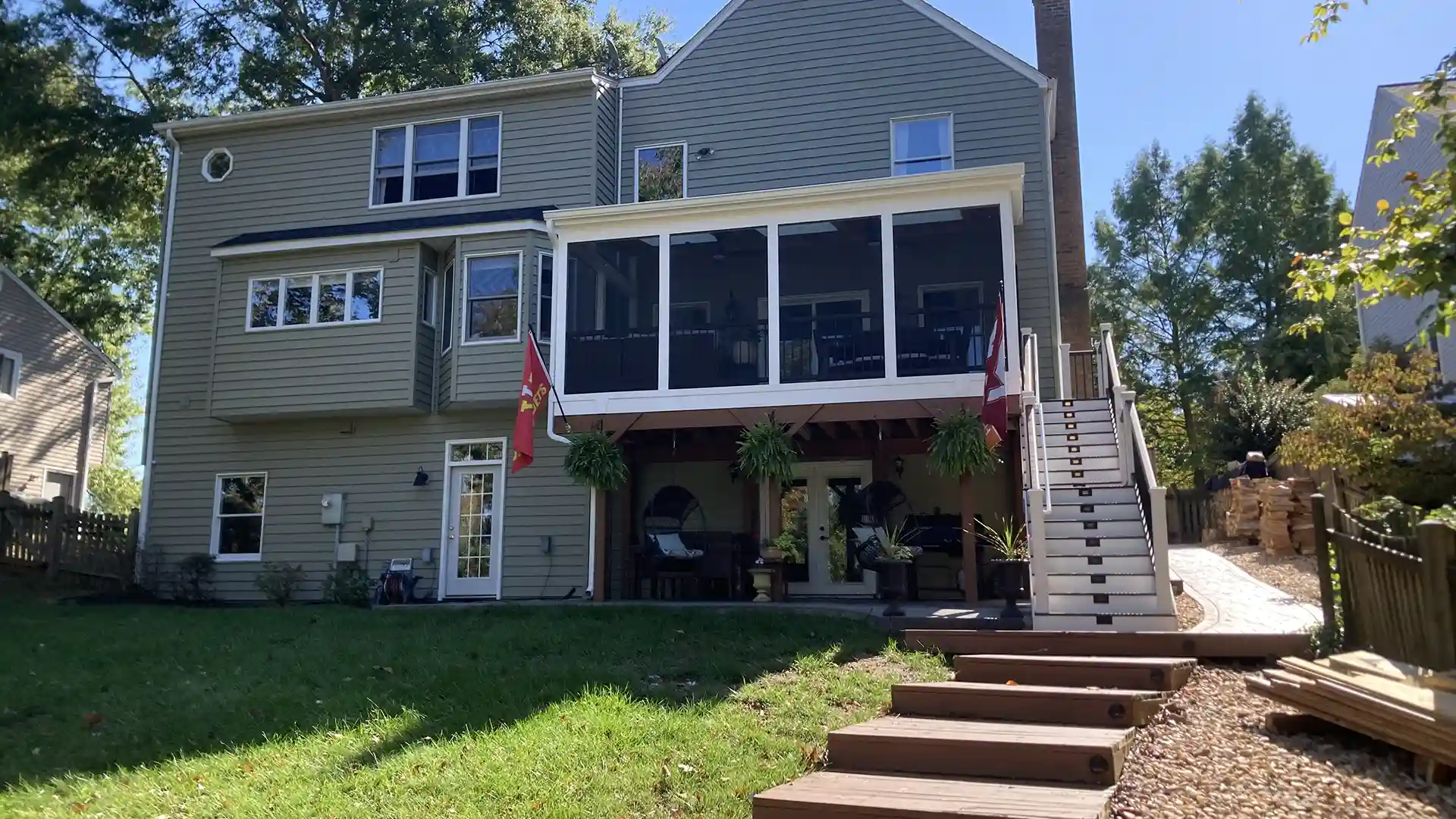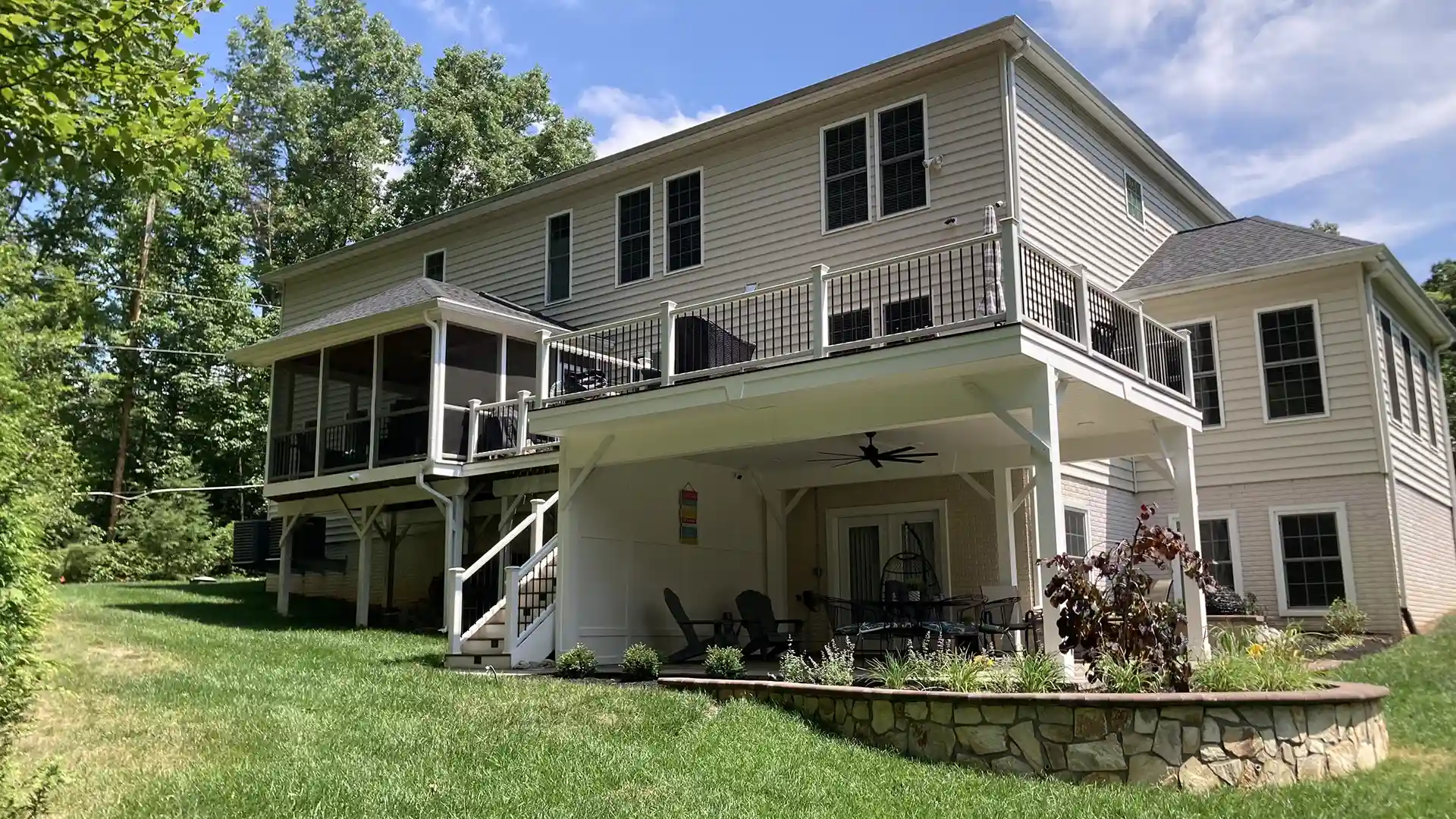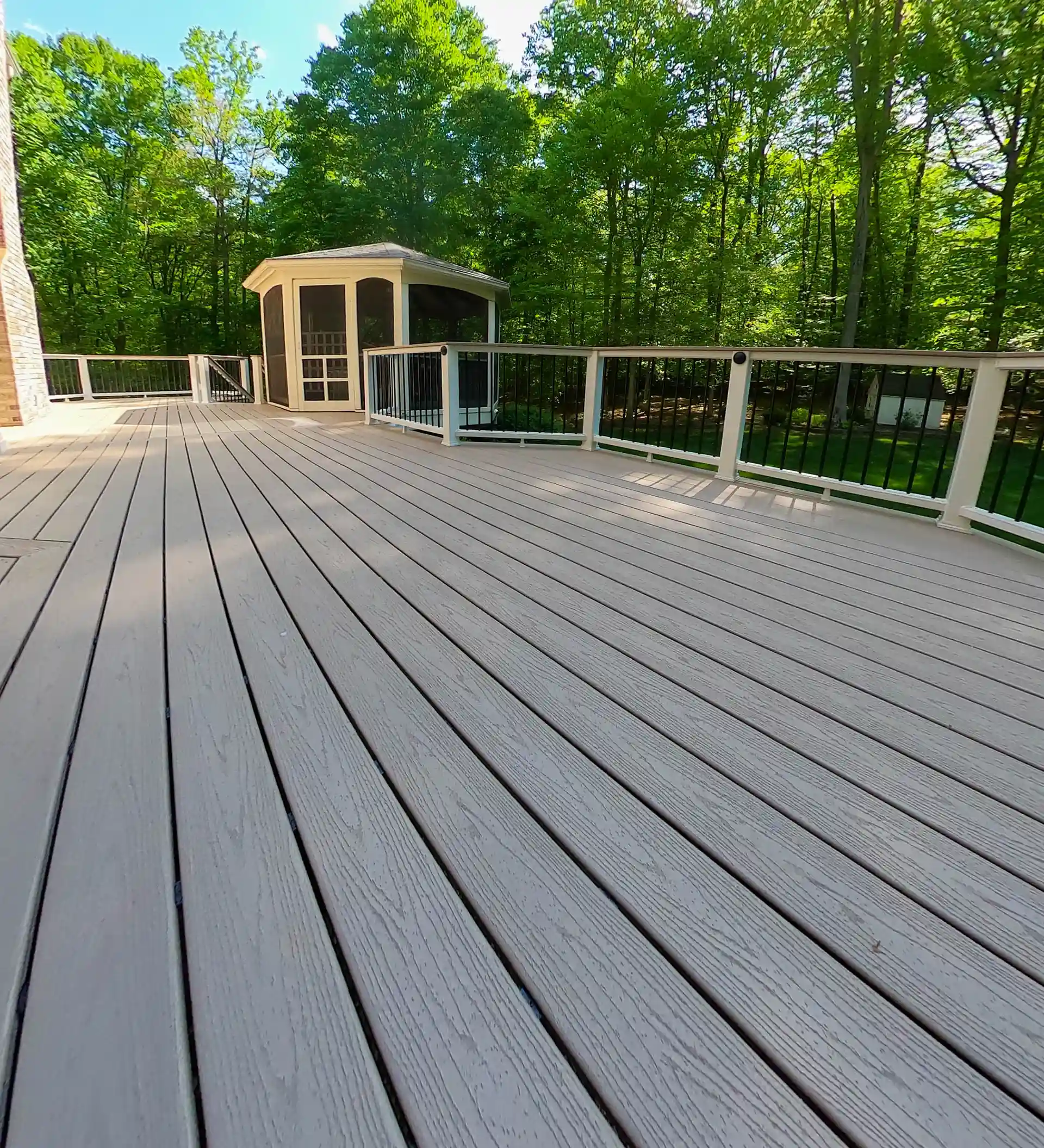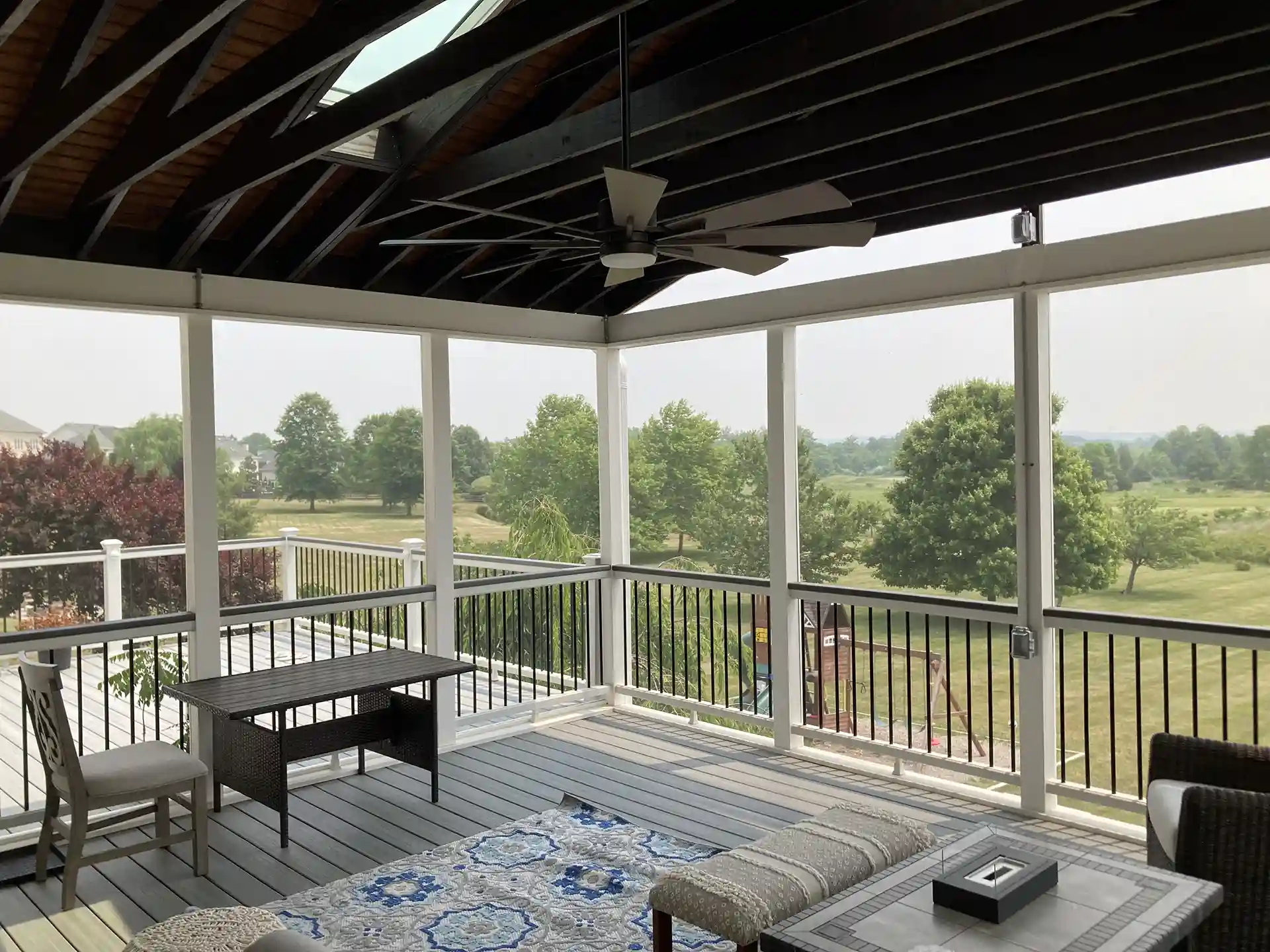
Heat builds fast on a sunlit deck. By mid-afternoon, boards can feel like a griddle under your feet, especially if there’s no shade, no airflow, and the surface traps solar energy. This isn’t just uncomfortable—it limits how and when you can use the space. If you’re working with a local deck contractor on a new build or considering a deck installation, summer heat should be one of your first design considerations.
Why Does Your Deck Get Hot in the Summer
Deck surfaces absorb and store solar radiation throughout the day. Darker colors, dense materials, and low airflow around the structure all contribute to rising surface temperatures. On a clear day, temperatures can spike 30 to 50 degrees hotter than the surrounding air, especially on decks with no overhead cover or poor ventilation underneath.
Heat buildup is worst on south- or west-facing decks that receive direct afternoon sun. The longer the exposure, the more radiant heat the boards hold. Without shade or a means to circulate air, the heat remains trapped, rendering the space nearly unusable during peak daylight hours.
Cool Decking Materials
Not all deck boards react the same to heat. The material you choose directly affects surface temperature, foot comfort, and long-term durability in high-sun exposure environments.
- PVC Decking: PVC is a plastic-based material with no organic content, which means it retains less heat than composite or wood. It’s lightweight, resistant to moisture, and reflects heat better when made in lighter shades. However, smooth PVC surfaces can become slick when wet and may expand slightly under intense heat, unless they are installed with the correct spacing.
- Mineral-Based Composite (MBC): Deckorators uses a patented Eovations™ technology in their Voyage and Vault lines. This creates a lightweight core filled with air pockets, helping the boards stay structurally stable and cooler underfoot. MBC boards have low thermal expansion and virtually no moisture absorption, making them highly stable in hot climates.
- Traditional Wood-Plastic Composite: These boards combine wood fibers and recycled plastics. Without cooling additives, they tend to heat up quickly and hold that heat longer, especially in darker colors.
Some newer versions include reflective additives, like MoistureShield’s CoolDeck technology, which can reduce surface temperatures by up to 35% compared to uncapped composites. - Aluminum Decking: Aluminum reflects solar radiation efficiently, keeping its surface cooler and shedding heat rapidly once shaded. It won’t warp, rot, or splinter, and it’s fully fireproof and slip-resistant.
Its higher cost and more metallic feel make it more common in commercial or rooftop settings than in residential backyards.
Composite Decking: The Best Option for Summer Heat
Composite deck materials are not created equally when it comes to heat performance. Most fall into three categories, and each one behaves differently under direct sunlight:
- Standard Wood-Plastic Composite: These are made from a blend of wood fibers and polyethylene or polypropylene. The porous nature of the wood content allows it to hold moisture and heat. In full sun, surface temperatures often exceed 140°F and remain hot well into the evening.
- Capped Composite: These boards feature a polymer cap bonded to the core, which helps resist moisture and UV damage. However, not all caps reflect heat. Polyethylene caps without additives can trap warmth, while advanced versions with light-scattering compounds help lower surface temperature and control thermal expansion.
- Mineral-Based Composite (MBC): These contain no wood fiber. Instead, they use polypropylene mixed with mineral fillers and microscopic air pockets that reduce mass and slow thermal buildup. They are non-porous, stay dimensionally stable, and typically feel cooler to the touch than any other composite option.
- Color and Texture Matter: Lighter colors reflect sunlight more effectively than darker ones. Embossed or ribbed textures also help dissipate heat faster than smooth boards. Installation matters too—allowing airflow beneath the deck can significantly lower ambient and surface temperatures.
Wood Decks and Heat
Wood decking absorbs and retains more heat than most composite materials. The extent depends on the wood’s density, moisture content, and finish.
- Hardwoods like Ipe and Cumaru are very dense, making them both durable and excellent at retaining thermal energy. In full sun, they become hot underfoot and stay that way well after sunset.
- Softwoods like cedar and redwood cool down faster, but when stained in dark tones or installed without shade, they can still overheat.
- Pressure-treated pine darkens over time, and without sealing or adequate airflow, it warps and heats unevenly.
Smoother wood finishes reflect less light and retain more heat. Over-sanding wood decks can increase the likelihood of heat retention unless paired with good airflow and protective covering.
Ideas to Keep Your Deck Cool in Summer
Deck heat isn’t just a comfort issue—it’s a material issue, a usability issue, and in some cases, a safety issue. If you’re trying to figure out how to keep deck cool in summer, don’t settle for temporary fixes. Each of these strategies blocks heat, moves air, or utilizes smart design to modify how your deck handles direct sunlight.
Structural Shade: Fixed Solutions That Block Heat at the Source
Some decks need full overhead coverage, not partial shade or shifting umbrellas. If your deck is exposed from mid-morning through late afternoon, structural shade is the most reliable way to reduce temperature and protect your investment.
Professional decking contractors often recommend integrating fixed or retractable shade during deck installation to manage solar exposure from the start.
- Pergolas: These open-beam structures cut down direct light while still allowing ventilation. For better performance, increase rafter spacing to limit sun penetration during peak hours. Pergolas can be built with solid slats, louvered panels, or wood framing and later dressed with vines or retractable fabric.
Best for decks that see morning-to-midday sun and where partial shade is acceptable. - Covered Deck Roofs: A solid roof—pitched or flat—blocks the sun entirely and helps control deck heat across the entire surface. It turns the space into a usable zone during extreme summer heat, and it supports the installation of ceiling fans, recessed lighting, and outdoor heaters.
Ideal for year-round decks and homeowners seeking consistent shade from spring through fall. - Louvered Roofs (Manual or Motorized): These offer complete control over sun, wind, and airflow. Louvers can be opened for sky views or closed during peak sun, and some motorized systems respond to rain sensors.
These are ideal for homeowners who frequently entertain and want precise shade control throughout the day.
Adaptable Shade: Movable Options That Follow the Sun
If you want flexibility without committing to permanent construction, movable shade works well, especially for decks with variable sun angles or changing seasonal use.
- Cantilever Umbrellas: These freestanding umbrellas pivot and tilt to cast shade exactly where it’s needed. Unlike center-post designs, the base is positioned off to the side, ensuring it won’t block foot traffic or seating arrangements.
Use one over a dining area, lounge chairs, or a play zone. A good option for renters or homeowners with changing furniture layouts. - Shade Sails: These tensioned fabric triangles or rectangles attach to posts, eaves, or walls. They diffuse UV rays while still allowing airflow underneath. Select UV-resistant fabric and install it at varying heights to maximize coverage.
Excellent for oddly shaped decks or spaces with limited overhead clearance. - Retractable Awnings: Wall-mounted awnings can be extended or retracted depending on the time of day. Manual and motorized versions are available, and some include integrated LED lighting or wind sensors.
Ideal for decks adjacent to living spaces where window glare and indoor heat gain are also concerns.
Green Cooling: Shade That Grows and Breathes
Nature has its way of cooling surfaces. Trees, vines, and large-leaf plants don’t just block sunlight—they release moisture through transpiration, which actively reduces air temperature near the deck. These green strategies require more planning but offer long-term benefits that do not rely on mechanical systems.
- Tall Planters with Purpose: Skip decorative pots and opt for strategic plantings. Use tall planters filled with fast-growing ornamental grasses, columnar shrubs, or dwarf trees like Japanese maple. These create small pockets of movable shade, helping to reduce reflected heat along railings and adjacent windows.
Rotate them throughout the season to align with the changing sun angles. Best near seating areas or entry points where radiant heat tends to concentrate. - Trellises With Climbing Vines: Vertical trellises or arched frames paired with the right plant can turn a bare wall into a living sun filter. Vines like clematis, Virginia creeper, or grapevine proliferate and create dense shade by early summer.
These plants adapt as the seasons shift, allowing filtered light to pass through while still absorbing it. Ideal for decks with limited overhead structure or those facing west. - Integrated Green Walls: For homeowners ready to commit, modular green wall panels can be mounted to a fence or privacy screen. These systems use vertical planters to grow dense plant layers that block heat and glare.
When combined with irrigation and proper drainage, they become self-sustaining and highly effective in small yards or urban decks. - Potted Trees for Passive Cooling: Small ornamental trees in large containers offer height and canopy with seasonal flexibility. Look for species with broad, dense foliage—like serviceberry, olive, or river birch—that can handle reflected heat from deck boards.
Place them on casters to shift as needed. Works well for decks that can’t support structural shade but need sun relief in summer months.
Green cooling doesn’t just improve comfort—it softens hardscapes, increases privacy, and adds real thermal function to your deck. It’s also one of the few strategies that gets better with time.
Active Airflow: Keep the Heat Moving
Sometimes the issue isn’t just sun—it’s stagnant air. If your deck traps warm air under a roof or between solid walls, it needs to be ventilated.
- Ceiling Fans or Wall-Mount Outdoor Fans: Fans don’t cool air, but they move it, breaking up the layer of warm air that collects near the surface. Install under covered decks or on pergola beams. Choose damp-rated models with sealed motors. Works best when paired with partial shade.
- Misting Lines: These use low-pressure nozzles to spray fine water mist that evaporates instantly, dropping the air temperature by several degrees. Mount along beams, railings, or shade frames. Avoid using in high-humidity areas, where mist can increase discomfort.
Surface Protection: Stop the Heat Where You Step
Even the right material can get hot under the sun. If you’re walking barefoot or spending time with pets or kids, reducing contact heat matters.
- Outdoor Rugs and Runners: Place UV-stable, breathable rugs over high-traffic areas or lounge zones. These protect feet from surface heat and reduce thermal absorption into darker composite decking boards. Look for options that allow drainage and resist mildew.
- Deck Panels or Temporary Shade Mats: Modular panels or roll-out fabric mats can be placed seasonally over key areas, such as grill stations or kids’ play zones, and then stored during cooler months. Suitable for decks that only need protection during part of the day.
FAQs
How do I keep my deck from getting hot?
The most effective way to prevent heat buildup is to select materials that do not trap solar energy. Decking made from mineral-based composite or PVC reflects heat more effectively, especially in light shades. Structural shade, such as a pergola or covered deck, blocks direct sunlight. Adequate airflow beneath the deck also helps heat escape throughout the day.
How to deal with a hot deck?
Focus on surface insulation, shade deflection, and air circulation. Use outdoor rugs or modular panels in high-traffic zones, and install retractable awnings or umbrellas where the sun hits hardest. Fans or misting systems move warm air out, cooling the deck’s microclimate and making the space more usable in the afternoon.
How do I protect my deck from the sun?
Use structures that reduce UV exposure and keep surfaces dry. For wood decks, reapply UV-rated sealants every one to two years. Composite and PVC decks don’t require sealing, but keeping them clean helps prevent heat-trapping buildup. Covered decks and shade sails provide consistent protection throughout the season.
Does wood decking get hot in the sun?
Yes—especially hardwoods and dark finishes. Dense species like Ipe absorb and retain more heat than softwoods. Smooth finishes and darker stains trap more radiant energy, and even well-maintained wood can stay hot into the evening without overhead shade.
What decks don’t get hot?
Mineral-based composites and capped composites with cooling additives perform the best in full sun. PVC and aluminum boards in pale shades also stay cooler, especially when paired with airflow and partial shade. These materials are ideal for open decks in Alexandria, VA, that receive intense afternoon sun.
Get a Cooler Deck with the Right Materials and Design
You don’t have to live with a deck that overheats every summer afternoon. With the right combination of materials, airflow, and shade strategy, your deck can remain comfortable, usable, and safe throughout the entire season. Contact Prince William Home Improvement today to get a free estimate and work with a Deck Contractor trusted throughout Alexandria, VA for expert Deck Installation and Deck Construction.
Don’t let the intense summer sun limit your deck’s potential—our team of experienced decking contractors will help you make the most of every square foot.





